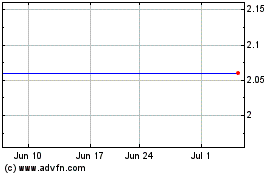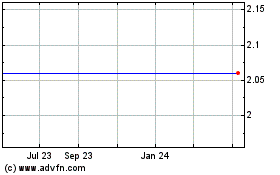First Volunteers Dosed in Phase I Clinical Trial of PBT434, Prana’s Lead Therapy for Parkinsonian Diseases
July 03 2018 - 9:38PM
Business Wire
Highlights:
- Prana enrols and doses its first
cohort of healthy volunteers in its Phase I clinical trial
- Evidence supports activity of PBT434
to prevent α-synuclein accumulation and neuron loss in experimental
animal models of parkinsonian diseases
- Transition to human trials is a
milestone for the Company building on its well-established
scientific foundations
- Highly experienced drug development
team, based in San Francisco, leading the program
Prana Biotechnology Ltd (ASX PBT: NASDAQ PRAN) is pleased to
announce the first cohort of volunteers in its Phase I clinical
trial have been administered PBT434, an experimental drug under
investigation for the treatment of Parkinsonian diseases.
The trial conducted in Melbourne, Australia is recruiting and
dosing healthy adult and elderly volunteers, to ascertain the
optimal drug dose. The primary goal of the Phase 1 clinical trial
is to demonstrate the safety and tolerability of PBT434, with a
secondary endpoint of pharmacokinetic measures assessing and
understanding how the drug is absorbed and metabolised in the human
body.
PBT434 is the first of a new generation of small molecules
designed to inhibit the aggregation of alpha(α)-synuclein and tau,
critical intracellular proteins that are implicated in
neurodegenerative diseases such Parkinson’s disease and atypical
parkinsonism. PBT434 has been shown to reduce the pathological
accumulation of these proteins in animal models of disease and has
excellent potential to treat various forms of atypical
parkinsonism, such as Multiple System Atrophy (MSA) and Progressive
Supranuclear Palsy (PSP).
Prana’s Chief Medical Officer and Senior Vice President,
Clinical Development Dr David Stamler, MD, said: “The first human
administration of PBT434 is a major milestone for Prana. MSA and
PSP are devastating diseases with no effective treatments and this
is an important first step in developing a therapy for individuals
with these diseases.”
The development program for PBT434 is being led by Dr Stamler
from Prana’s San Francisco office. Dr Stamler and his team are
highly experienced and have brought several new drugs to market,
including deutetrabenazine for the treatment of Huntington’s
disease chorea and Tardive dyskinesia, both of which were approved
by the U.S. Food and Drug Administration (FDA) in 2017. This was
the second neurological agent that Dr Stamler has led through the
approval process with the FDA.
About Prana Biotechnology:
Prana’s lead candidate, PBT434, is the first of a new generation
of small molecules designed to inhibit the aggregation of
pathological proteins implicated in neurodegeneration. PBT434 has
been shown to reduce abnormal accumulation of α-synuclein and tau
proteins in animal models of disease by restoring normal iron
balance in the brain. In this way, it has excellent potential to
treat various forms of atypical parkinsonism such as Multiple
System Atrophy (MSA) and Progressive Supranuclear Palsy (PSP).
View source
version on businesswire.com: https://www.businesswire.com/news/home/20180703005657/en/
Investor Relations and MediaWE BuchanScott Newstead, +61
3 9866 4722snewstead@we-worldwide.com
Prana Biotechnology Ltd ADS (NASDAQ:PRAN)
Historical Stock Chart
From Oct 2024 to Nov 2024

Prana Biotechnology Ltd ADS (NASDAQ:PRAN)
Historical Stock Chart
From Nov 2023 to Nov 2024
